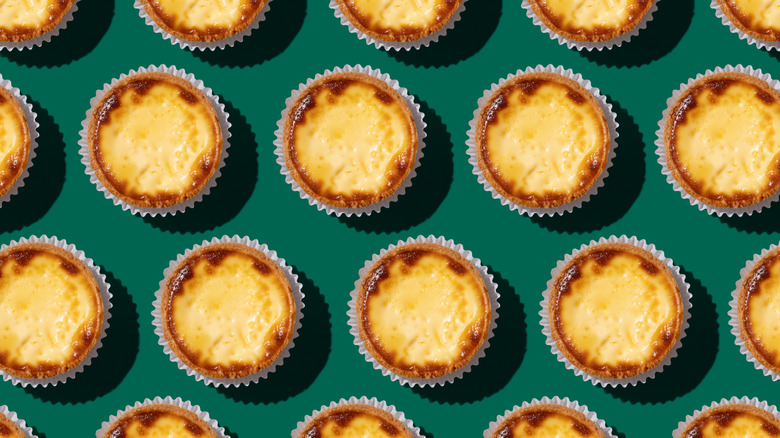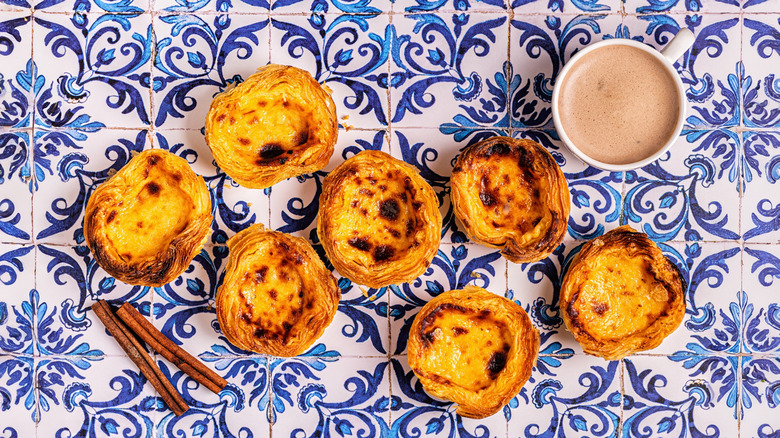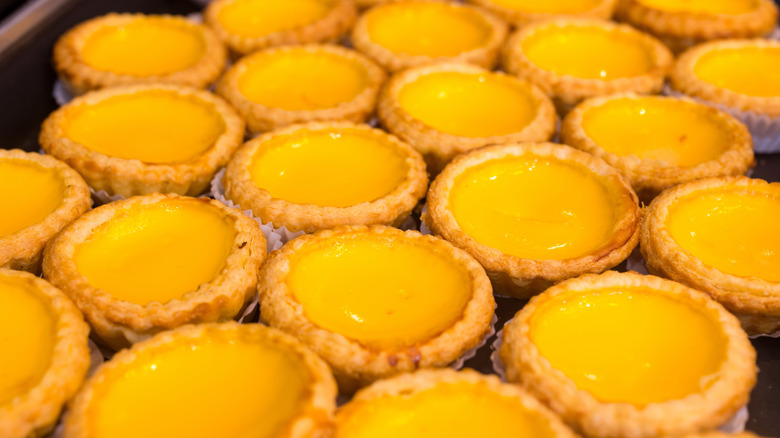The Differences Between Portuguese And Chinese Egg Tarts
Portuguese and Chinese egg tarts are both iconic pastries in their respective culture's cuisine. These small treats have a creamy, custard-like egg center baked in a pastry crust; and while these egg tarts are indeed very similar, they each have their own twist that makes them a cultural staple. Chinese egg tarts are actually a riff on Portuguese custard tarts, while the Portuguese tarts are their own invention dating back to 1200s — but both recipes are descendants of French and British custards.
The main difference between these two, aside from their origins, is whether they use puff pastry or classic pie crust and if the tops of the tarts are caramelized. Some of the ingredients remain the same between the two recipes but the amount of eggs and flavoring agents differ, which also accounts for why Chinese egg tarts are lighter in color than the Portuguese.
What is a Portuguese egg tart?
The Portuguese egg tart, locally known as pasteis de nata (which means "cream pastry") and also sometimes called Portuguese custard tarts, have evolved to be a worldwide sensation. Legend says that in the 13th century, Portuguese monks with backgrounds in French pastry first developed the tart as a way to use up egg yolks. Generations later, their descendants sold the recipe to a sugar refinery who sells egg tarts using the original recipe to this day. But what are pasteis de nata?
To make these egg tarts, bakers first start with a homemade puff pastry that creates a layered flaky crust around the custard. Then the filling is made using egg yolks, whole milk, flour, cinnamon, and sugar, which melts to make a crisp shell on top of the tart, very similar to a basic creme brulee. The result is a rich creamy filling baked inside a light crust that you won't be able to resist when cooked correctly. Note that these tarts require a special tin that is specifically sized — you can use a muffin tin in a pinch, but it won't expose the custard to heat as evenly.
What is a Chinese egg tart?
The Chinese egg tart has a few key differences to the Portuguese egg tart, despite being a descendant of the original Portuguese recipe. These egg tarts are also called Hong Kong egg tarts, or dan tat in Cantonese, and can also be found in Macau, but the Macau tarts have a different recipe of their own. Regardless, all forms of the Chinese egg tart come from recipes brought by Portuguese and British colonizers whose cooking was adapted into Chinese culture. The egg tart is now an extremely popular dish at dim sum restaurants and Chinese bakeries — and according to pastry chef Pichet Ong, they make for the perfect Asian dessert — but they look a bit different than the original Portuguese pastries.
While the Chinese dough is still made by hand, it resembles a classic pie crust and doesn't have flaky layers like its Portuguese ancestors. The custard itself uses much fewer eggs — three to the Portuguese six — and uses the whole egg rather than separating the yolk. The Chinese tarts use evaporated milk and vanilla to create a lighter custard, and you'll notice the distinct absence of the signature Portuguese burnt tops. This may be due to British influence, as British custard tarts also lack a crispy top. Yet, while the recipes do differ, the pastries remain an undeniably delicious piece of both Chinese and Portuguese cuisine.



